- Tour Enquiry
- Sign up | Login
- My Bookings
- New User? Sign-up
- Domestic Tours
- South India
- Maharashtra
- Golden Triangle
- North India
- North East India
- International
- Maldives (Discontinued)
- All Domestic Tours
- All International Tours
- Offbeat Tours
- Domestic Cruise Tours
- Jungle Lodges by JLR
- Kabini River Lodge
- Bandipur Safari Lodge
- JLR Kings Sanctuary
- River Tern Lodge
- Kali Adventure Camp
- Hampi Heritage & Wilderness Resort
- K Gudi Wilderness Camp
- Car Rentals
- Destinations
- Tourist Places on Drive
- Driving Directions
- * Workation
- * Tour Plans
- List Property
- Places to Visit in Amaravati

6 Top Tourist Places to Visit in Amaravati
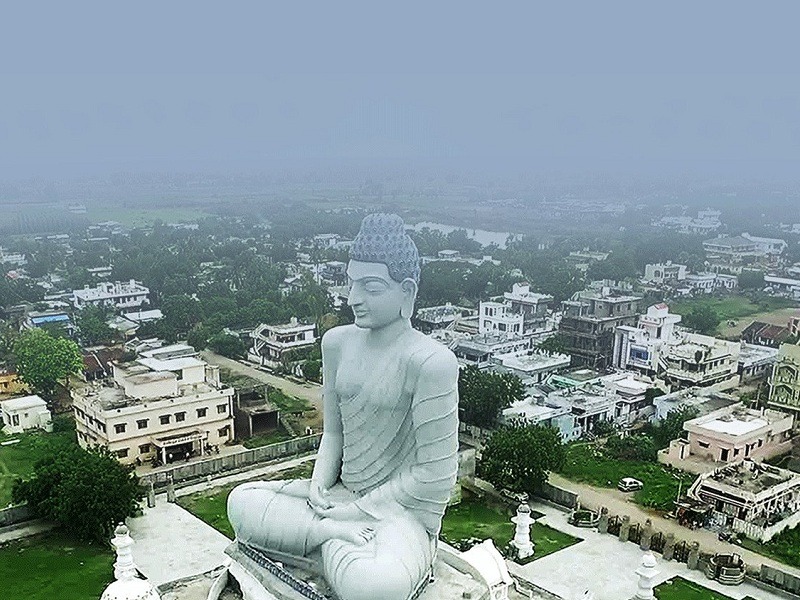
- Amaravati Overview
- Top 6 Places to Visit in Amaravati
- 1 Best Amaravati Tour Packages
- Top Resorts in Amaravati
- Best Time to Visit Amaravati
- How to Reach Amaravati
- Driving Directions to Amaravati
- within 1 km
- within 5 km
- within 10 km
- within 20 km
- within 30 km
- within 40 km
- within 50 km
Amaravati Stupa / Mahachaitya

#1 of 6 Places to Visit in Amaravati
At a distance of 1 km from Amaravati Bus Station, Amaravati Stupa is a ruined Buddhist monument located in Amaravati, Andhra Pradesh. Popularly known as Mahachaitya or Great Stupa of Amaravati, it is one of the largest stupas in India and among the must visit places in Amaravati. The great Buddhist Stupa or Mahachaitya of Amaravati is one of the greatest architectural achievements of ancient India. It was founded in the 3rd-2nd centuries BC during Ashoka Maurya' reign and enlarged in the 1st-4th centuries AD under the Satavahana and Ikshvaku patronage. It was a center of religious activities till the 14th century AD. Eventually, it fell into disuse and was rendered invisible by being covered in dust and debris over the course of time. The mound was discovered in 1796, when the workmen of a local zamindar, the Raja of Chintapalli, stumbled upon the ruins. A year later, Colin Mackenzie, a British army officer, came upon the site and became the first to document the stupa. Subsequently .....
...read more
Amaravati Museum
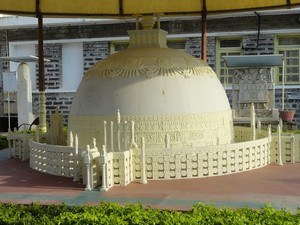
#2 of 6 Places to Visit in Amaravati
At a distance of 500 m from Mahachaitya and 1 km from Amaravati Bus Stand, Amaravati Museum is an archeological museum situated in Amaravati, the de-facto capital of Andhra Pradesh, India. Just opposite to Amaravati Stupa, it is one of the popular museums in Andhra and among the top places to visit in Amaravati as part of Vijayawada Tour Packages. Maintained by ASI, the Amaravati Museum is an amazing repository of relics that have been gathered from the ruins of this 2000 year old Buddhist settlement as well as from nearby places. These artefacts belong to the period 3rd century BC to 12th century AD exhibit in three different galleries. The ancient and complex art work done by the craftsmen of that period are displayed in the first gallery. The Purnakumbha designs and the Lotus designs here express the intricate art of those days. The two drums of slab depicting the Stupas, Swastika mark on the cushioned seat of the throne under the Bodhi tree, the Agni Skanda (Flaming pillar), the .....
Amareswara Temple
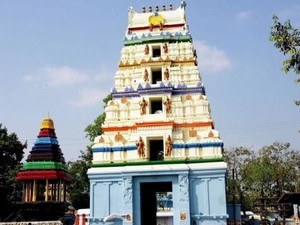
#3 of 6 Places to Visit in Amaravati
At a distance of 1.5 km from Amaravati Bus Station, Amareswara Temple is a Hindu temple situated on the bank of Krishna River in Amaravati, Andhra Pradesh. Also called as Amaralingeswara Swamy Temple, it is one of the well-known places of pilgrimage in Andhra Pradesh and among the popular places to visit in Amaravati. Dedicated to Lord Shiva, Amaralingeswara Temple is regarded as one of the Pancharama Kshetras of Lord Shiva. The other four places are Draksharama, Kumararama at Kotipalli, Bheemarama at Samalkota and Ksheerarama at Palakollu. Legend has it that when Subramanya killed the demon Tarakasura, the Shivalingam in his throat broke and fell in five different spots, which became the Pancharama kshetras. It is believed that the sacred Shivalinga of Amareswara Swamy Temple was installed by Lord Indra himself. Though the origin of the temple is shrouded in the Puranas, the temple was renovated and expanded by Vasireddy Venkatadri Naidu, who was the zamindar of Chintapalli .....
Dhyana Buddha Statue
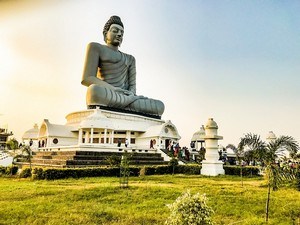
#4 of 6 Places to Visit in Amaravati
At a distance of 2 km from Amaravati Bus Station, the Dhyana Buddha is a statue of Lord Buddha situated in Amaravati, Andhra Pradesh. It is one of the tallest Buddha statues in India and among the most important places to visit in Amaravati. Standing tall at a height of 125 feet, the statue of Dhyana Buddha was commissioned in 2003 and completed in 2015. The statue is situated in 4.5 acre scenic locale on the bank of Krishna River. Made out of concrete and stone, this giant statue was sculpted by R. Mallikarjuna Rao, the Joint Director of Social Welfare, Guntur. The statue was designed by incorporating features from all the 50 types of Buddhist sculptures from 145 major heritage sites all over India. The statue is in meditating posture while he is seated on a giant lotus supported by eight pillars symbolizing the Buddha's eight fold path to attain salvation. The area is divided into four zones depicting the four noble truths. The five ayaka pillars made of sand stone symbolize .....
Kondaveedu Fort
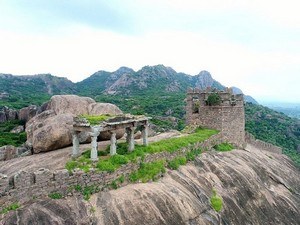
#5 of 6 Places to Visit in Amaravati
At a distance of 32 km from Guntur, 58 km from Amaravati and 73 km from Vijayawada, Kondaveedu Fort is an ancient hill fortress located at Kondaveedu village in Guntur district of Andhra Pradesh. It is one of the historical forts in Andhra Pradesh and among the famous Amaravati Tourist Places. Kondaveedu Fort was constructed during the time of Telugu Chodas, strengthened by Kakatiyas and occupied by Prolaya Vema Reddy who shifted his capital from Addanki to Kondaveedu in 1323 AD. Later it was taken over by Gajpathis of Orissa and ravaged by the Bahmani Sultans in 1458. The Vijayanagara emperor Krishnadevaraya captured it in 1516. The Golconda Sultans fought for the fort in 1531, 1536 and 1579, and Sultan Quli Qutb Shah finally captured it in 1579, renaming it as Murtuzanagar. Later it was recaptured by the Mughal army of Aurangzeb in 1687 and the fort came under the control of the French colonists in 1752 when it was extensively fortified. It passed on to the English imperialists .....
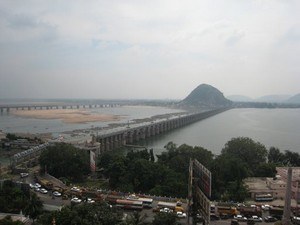
#6 of 6 Places to Visit in Amaravati
At a distance of 37 km from Guntur, 273 km from Hyderabad, 354 km from Vizag , 453 km from Chennai and 643 km from Bangalore, Vijayawada, also known as Bezawada, is the second largest city in Andhra Pradesh State and also one of the top Places to visit in Andhra Pradesh . It is located on the banks of the Krishna River to the South, Budameru River on the north and the Indrakiladri Hills on the west. This is the largest railway junction of the South Central Railway, situated along the Chennai-Howrah and Chennai-Delhi rail route. Legend says that Goddess Durga took rest in this sacred place after destroying a Rakshasa and since then the name 'Land of Victory' or Vijayawada came into existence. The discovery of Stone Age artifacts along the banks of River Krishna from Machilipatnam to Nagarjuna Sagar indicates that this area was inhabited long before. The Chalukyas once conquered this place and it was ..... Distance (From Amaravati): 38 Kms Trip Duration (From Amaravati - Including Travel): Full Day .....
Amaravati Blogs
Amaravati related packages, amaravati related pages.
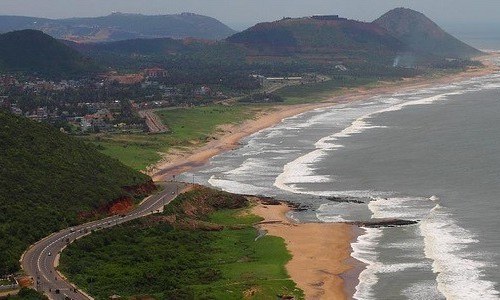
Places to Visit in Popular Sites in India
- Coorg Tourist Places
- Ooty Tourist Places
- Munnar Tourist Places
- Shimla Tourist Places
- Mahabaleshwar Tourist Places
- Chikmagalur Tourist Places
- Wayanad Tourist Places
- Pondicherry Tourist Places
- Goa Tourist Places
- Andaman Tourist Places
- Hampi Tourist Places
- Ajanta Ellora Tourist Places
- Lonavala Tourist Places
- Nainital Tourist Places
- Agra Tourist Places
- Jaipur Tourist Places
- Kodaikanal Tourist Places
- Darjeeling Tourist Places
- Ratnagiri Tourist Places
- Murudeshwar Tourist Places
- Varanasi Tourist Places
- Ayodhya Tourist Places
- Madurai Tourist Places
- Rameswaram Tourist Places
- Shirdi Tourist Places
- Dwarka Tourist Places
- Somnath Tourist Places
- Yercaud Tourist Places
- Dandeli Tourist Places
- Thekkady Tourist Places
- Mussoorie Tourist Places
- Kerala Tourist Places
- Tamilnadu Tourist Places
- Karnataka Tourist Places
- Maharashtra Tourist Places
- Orissa Tourist Places
- Sikkim Tourist Places
- Kashmir Tourist Places
Near By Places

Similar Places
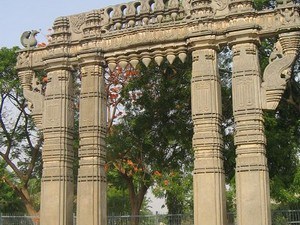
100% SECURE PAYMENTS
Domestic & International Cards Accepted

Our WhatsApp Numbers
Kerala, Tamilnadu, AP & TG Tours
Karnataka Tours
Goa, Maharashtra, Gujarat Tours
North India Tours
Rest of India
International Tours
Request Quote
Travellers #
Explore Tour Packages
Discover Affordable Tour Packages
Need Customized Tour? Request Quote
Login / sign-up.
Your Sign in was successful! Itinerary will be downloaded shortly.
Sign up with Trawell.in
Already Created Account? Login Here
Sign in with Trawell.in Account
Forgot Password?
New User? Sign Up Here
Activate Your Trawell.in Account
Your account is activated successfully. Login Here
Reset Your Trawell.in Password
Your password has been reset successfully. Login Here
Booking Policy
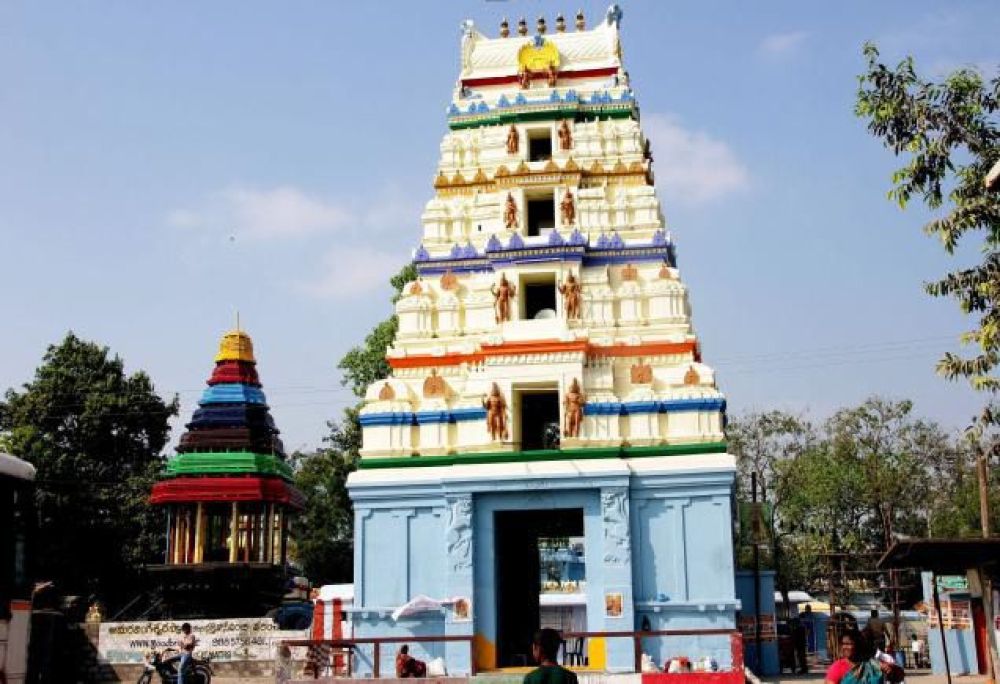
Amareswara Temple Tourism
- Amareswara Temple
- Best time to visit
- Tourist Map
- within 25kms
- within 50kms
- within 100kms
- within 150kms
- within 200kms
- within 250kms
- within 300kms
- within 500kms
Opening and Closing time of Amareswara Temple
Disclaimer: It's important to check the most current information before planning your visit, as opening hours can vary and might be subject to change due to special events, maintenance, or unforeseen circumstances. A reliable way to confirm the opening hours is to contact the local tourism board, check the official website (if available)
Entry Ticket Pricing for Amareswara Temple
Disclaimer: Please note that prices are subject to change, cross check required .
Tips when you are visiting to Amareswara Temple
Other Suggested Reads for Amareswara Temple
- Best time to Visit in Amareswara Temple
- Amareswara Temple Tourism History
- FAQS about Amareswara Temple
- Amareswara Temple Tourist Map
- Corporate Tours
- +91-9090403075
- Leh Ladakh Bike Trips
- Himachal Pradesh
- Uttarakhand
- Weekend Getaways
- Spiti Valley
- Honeymoon Packages
- International Trips
- India Trips
Weekend Trips
- Group Tours
18 Best Places To Visit In Guntur: Off-Beat Andhra Pradesh
Visitors can explore the historical Kondaveedu Fort, be amazed at the intricate carvings of Undavalli Caves, and experience the vibrant local culture at the busy Bapatla Beach. Whether indulging in spicy cuisine or enjoying a leisurely boat ride on Nagarjuna Sagar Dam, places to visit in Guntur promise a memorable journey through the heart of Andhra Pradesh’s beauty.
So, get ready to explore its historic sites, immerse yourself in local culture, and embark on scenic hikes that reveal the true essence of these beautiful places to visit in Guntur with our Guntur sightseeing guide…!!!
Also Read: 20 Best Places To Visit In Chittoor | Add To Your Bucket List Now!
18 Top Places to Visit in Guntur This Year
1. nagarjunasagar dam.
This engineering marvel stretches 16 kilometers in length and has a storage capacity of 11,472 million cubic meters, irrigating 9.81 lakh acres of land. Initially integral to India’s Green Revolution, it now serves dual roles: providing irrigation and generating hydroelectricity.
Beyond its utilitarian functions, the dam attracts several tourists to its glory and serene surroundings surrounded by lush greenery, offering a mesmerizing sight and reflecting its historical significance as an important irrigation project of India.
Timings: 06:00 AM – 08:00 PM Entry Fee: Adults – ₹ 20; Children – ₹ 15
2. Kondaveedu
Built in the 13th century by the Reddy kings, the fortress has 21 impressive structures that showcase its illustrious past. Located on the top of a hill, the fort offers breathtaking views and serves as a popular trekking destination.
Surrounding it are temples like Kathulabave and Gopunatha Temple, adding to its cultural richness. Kondaveedu Fort seamlessly blends natural beauty with historical significance, inviting visitors to explore its ancient marvels amidst picturesque landscapes.
Timings: Open All Days Entry Fee: Free
Also Read: Best Places To Visit In Sivaganga For An Unforgettable Journey!
3. Uppalapadu Nature Conservation
Migratory birds from as far as Australia and Siberia find refuge in the village’s water tanks. March and April, during the nesting season, offer the best opportunity to witness a variety of exotic birds in their natural habitat.
Timings: 06:00 AM – 08:00 PM Entry Fee: ₹ 20
4. Kotappakonda Trikutaparvattam
It offers beautiful views of majestic hills in every direction. The peaks—named after Hindu gods Vishnu, Brahma, and Maheswara—are steeped in mythology. Nearby, the Guthikonda Cave provides a captivating site for exploration.
Someswara Swamy Temple, situated in Sitanagaram about 16 miles northeast, is another popular destination well worth visiting. Thirunallu Festival is the Grand Festival celebrated in this temple.
Timings: 06:00 AM – 12:30 PM and 3:00 PM – 08:00 PM. Entry Fee: Free
Also Read: Top 10 Places To Visit In Thanjavur One Day Itinerary
5. Mangalagiri
It is one of India’s 8 important Mahakshetrams or holy places. According to legend, Lord Vishnu appeared here and Goddess Lakshmi performed penance on its hilltop.
Because of these divine associations, Mangalagiri attracts a large number of devotees year-round who come to pay their respects and seek blessings.
Timings: Panakala Lakshmi Narasimha Swamy Temple – 07:00 AM – 03:00 PM Sri Lakshmi Narasimha Swamy Temple – 05:00 AM – 08:30 PM Entry Fee: Free
6. Downtown
Popular spots of downtown include the Center of Brodipet, Arundelpet, Jinnah Tower Center, Naaz Center, Brindavan Gardens, Old Guntur, and Inner and Outer Ring roads. Manasa Sarovar, located on the eastern side, is a beautiful man-made park that adds to Guntur’s charm.
Also Read: 21 Places To Visit In Bagalkot That You Shouldn’t Miss
7. Amaravathi
Amaravati is a major pilgrimage and tourist destination. Originally established during Emperor Ashoka’s reign, the stupa now serves as a meditation center in the city. Amaravathi spans 217 kilometers of riverfront and is designed with 51% green spaces.
It was founded on October 22, 2015, by Prime Minister Narendra Modi. Following the division into two states in 2014, with Hyderabad becoming the capital of Telangana, Amaravathi was selected as Andhra Pradesh’s new capital, deriving its name from the ancient Satavahana dynasty’s capital.
The town attracts pilgrims year-round due to its numerous temples and sacred sites.
Time Required to visit: 1-2 days
8. Viswa Nagar
It is well-known for the Universal Integration Pillar and Viswayogi Viswamji, an important spiritual figure. Nearby is the Viswayogi Institute of Medical Sciences (VIMS), adding to the area’s significance as a hub for both spirituality and healthcare.
Time Required to visit: 5 – 6 Hours
Also Read: Explore 28 Places To Visit In Thanjavur In This Detailed Guide!
9. Krishna Barrage
It serves both as a road bridge and as a barrier that forms a lake. The barrage features three canals that cross Vijayawada, giving the city a Venetian-like appearance. Built primarily for irrigation purposes, it supports an irrigated area of 5.8 lakh acres.
During the rainy season or periods of heavy water flow, the barrage offers a pleasant spot to enjoy fresh air and scenic views.
Timings: Open All Day Entry Fee: Free
10. Suryalanka Beach
The beach is mesmerizing and offers crystal-clear waters of the Bay of Bengal. It’s spacious, allowing visitors to swim and sunbathe comfortably.
Also Read: 12 Best Places To Visit In Raichur For Every Traveller!
11. Bhattiprolu
Once a prosperous Buddhist town with a deep history, it now attracts not only Buddhist monks and devotees but also tourists curious to explore its ruins and admire the glory of the stupa.
12. Amaravati Stupa
Also known as the Maha Chaitya or Great Stupa of Amaravati, it is one of India’s largest stupas and a popular tourist attraction. Constructed in phases between the 3rd century BCE and 250 CE, the stupa features a circular vedika enclosing a depiction of Lord Buddha seated on an elephant.
The site includes an Archaeological Museum showcasing artifacts alongside the stupa itself, reflecting its historical significance and cultural richness.
Timings: 09:00 AM – 06:00 PM Entry Fee: Free
13. Undavalli Caves
The cave complex spans four floors, each adorned with multiple divine figures. It’s a fascinating site to explore with friends, offering a glimpse into the mysteries of ancient craftsmanship and religious symbolism.
Timings: 09:00 AM – 06:00 PM Entry Fee: ₹ 5
Also Read: 9 Best Historical Places To Visit In Raichur: Journey Through Past
Bhavani Island
For adventure enthusiasts, the island offers motorboats, parasailing, rock climbing, jet skiing, and other sports. Accommodation options include budget cottages and hotels, making it a great destination in Guntur for a fun and memorable vacation.
Sri Sri Radha Krishna Mandir
It hosts vibrant celebrations for festivals like Janmashtami and Diwali. The temple also offers programs for youth and children to enrich their spirituality. Visitors can enjoy the sacred food offerings (prasad) and soak in the peaceful atmosphere of the temple.
Timings: 04:30 AM – 01:00 PM; 04:30 PM – 08:30 PM Entry Fee: Free
Ethipothala Falls
It flows for about 3 km before joining the Krishna River. The Andhra Pradesh Tourism Department has set up a viewpoint on a nearby hillock to enjoy the waterfall. Managed by the Forest Department, there is a crocodile breeding center in the pond below the waterfall where visitors can observe crocodiles up close.
Two temples, dedicated to Ranganadha Swami and Dattatreya Swami, are located at the base of the waterfall, accessible via steps. Ethipothala Waterfall is ideal for mild trekking, and camping, attracting tourists to enjoy nature’s beauty.
Timings: 06:30 AM – 09:00 PM Entry Fee: ₹ 20
Also Read: Top 14 Places To Visit In Erode: A Complete Guide
Dindi Beach
The beach offers serene surroundings, ideal for leisurely walks or simply admiring the beautiful view. Known for its peaceful atmosphere, Dindi Beach is less crowded, making it a perfect destination for a relaxing getaway.
Kathula Bavi
Timings: 10:00 AM – 05:00 PM Entry Fee: Free
Also Read: Best Travel Guide To Top 28 Places To Visit In Visakhapatnam

Subscribe to our Newsletter
Subscribe to our newsletter to receive exclusive offers, latest news and updates.
Whether you’re drawn to ancient temples, scenic landscapes, or cultural heritage, places to visit in Guntur cater to all interests, making it a compelling destination for travelers seeking both discovery and relaxation in Andhra Pradesh.
So, next vacation must plan a trip to Guntur, Andhra Pradesh, and experience the charm of its heritage, from ancient temples to natural wonders with our Guntur sightseeing guide…!!!
Frequently Asked Questions (FAQS)
Q: 1. what is the best time to visit guntur, q: 2. are there any historical sites in guntur, q: 3. what activities can i do in guntur, q: 4. are there any religious places to visit in guntur.
Our Blog Post

Looking for a hassle free trip?
Connect with our experts! Get the best Itineraries and Offers!
We at WanderOn are a modern travel community that provides end to end travel packages in India and abroad. We design the best travel itineraries that encourage group traveling for like-minded people. Our services include road trips, trekking expeditions, corporate trips, and customized tour packages. On our trips, we ensure hassle-free traveling, top-notch accommodation and guided sightseeing that too in a budget that won't burn a hole in your pocket. Just give us your dates and be ready to experience traveling like never before.
- Bir Billing
- Chopta Tungnath
- Kasol Kheerganga
- Tirthan Valley
- Manali Solang
Himalayan Escapades
- Kasol Manali
- Parvati Valley
- Mcleod Bir Tirthan
- Mcleod Bir Barot
Backpacking Trips
- Himachal Backpacking
- Ladakh Trips
- Meghalaya Backpacking
- Kashmir Backpacking
- Beautiful Places to Visit in Spring in India
- Workcations: The New Trend of Travel
- Breathtaking Monasteries of Ladakh
- Soul-Satisfying things to do in Spiti Valley
- Mesmerising Waterfalls of Meghalaya to Visit
Quick Links
- Privacy Policy
- Cancellation Policy
- Terms & Condition
WANDERON EXPERIENCES PVT LTD
3rd Floor, Building No-436, Phase IV, Udyog Vihar, Sector-18, Gurugram, Haryana-122001
- [email protected]
- www.wanderon.in
© WANDERON EXPERIENCES PVT LTD, All rights reserved.
Where do you want to go next.
🗓 Best Time To Visit: October to March
⏰ Open Hours: 8 AM to 6 PM
🏞 Things To Do: Visit the stupa, museum exploration, photography, sightseeing
💰 Entry Fees: Free entry
👥 Traveller Types: Historians, Culture enthusiasts, Photo Fanatics, Family
📜 Known For: Historical significance, Buddhist architecture, Sculptural relics
🚉 Distances: From Guntur Railway Station - 37.5 km, From Vijayawada Airport - 47.5 km, From Vijayawada City - 38.5 km
♿ Accessibility: Wheelchair accessible
🎒 Tips: Wear comfortable footwear, Carry water bottles, Respect the sanctity of the place
🍽 Nearby Eateries: Local restaurants and food stalls available nearby
📚 History: Believed to be built during the reign of Emperor Ashoka
Amaravati Stupa: A Guide to the Ancient Buddhist Monument in Andhra Pradesh
Are you fascinated by the rich and diverse history of India? Do you want to explore the ancient and magnificent monuments that reflect the glory of the past? If yes, then you should not miss the opportunity to visit the Amaravati Stupa , one of the oldest and largest Buddhist stupas in the world. Located in the Guntur district of Andhra Pradesh, the Amaravati Stupa is a marvel of architecture, art, and culture that dates back to the 3rd century BCE.
In this article, we will tell you everything you need to know about the Amaravati Stupa, its history, architecture, significance, location, and tourism. Read on to discover the secrets of this amazing monument and plan your trip to witness its beauty and splendor.

Introduction
The Amaravati Stupa, also known as the Amaravathi Mahachaitya, is a circular mound-like structure that was built to commemorate the life and teachings of Gautama Buddha, the founder of Buddhism. The stupa is considered to be one of the most sacred and important sites for Buddhists, as it is believed to contain the relics of Buddha and his disciples. The stupa is also renowned for its exquisite sculptures and carvings that depict scenes from Buddha's life, Jataka stories, animal motifs, and floral patterns. The stupa is a masterpiece of art and style that influenced the development of Buddhist art in India and other regions. The stupa is currently under the protection and maintenance of the Archaeological Survey of India, which also runs an archaeological museum near the stupa that displays the sculptures and other findings from the site. The stupa is also a popular tourist attraction that attracts visitors from all over the world who want to learn more about the history, architecture, and significance of the stupa. In this article, we will provide you with a comprehensive guide to the Amaravati Stupa, covering the following topics:
- History of Amaravati Stupa
- Architecture of Amaravati Stupa
- Significance of Amaravati Stupa
- Location and Tourism of Amaravati Stupa
History of Amaravati Stupa
The history of the Amaravati Stupa is a long and fascinating one that spans over a thousand years. The stupa was originally built during the reign of Emperor Ashoka, who ruled over most of India from 268 to 232 BCE. Ashoka was a devout Buddhist who propagated the religion throughout his empire and beyond. He also erected many stupas and pillars across the country to mark the places associated with Buddha and his teachings. One of these stupas was the Amaravati Stupa, which was built on the banks of the Krishna river, near the ancient city of Dhanyakataka, which was the capital of the Satavahana dynasty. The stupa was also known as Dipaladinne or hill of lights, as it was said to glow with the light of the relics inside. The stupa was also visited by the famous Chinese pilgrim and monk Faxian, who described it as a grand and splendid structure in his travelogue.
The stupa underwent several expansions and renovations over the centuries, as different rulers and dynasties added their own contributions to the monument. The most notable of these were the Ikshvaku dynasty, who ruled over the region from the 3rd to the 4th century CE. The Ikshvaku kings were great patrons of art and culture, and they embellished the stupa with elaborate sculptures and carvings that covered the entire surface of the stupa. The stupa reached its peak of glory and size during this period, with a diameter of about 50 meters and a height of about 27 meters. The stupa also had five projecting rectangular platforms, called Ayaka platforms, that supported five pillars, called Ayaka pillars, that symbolized the five main events in Buddha's life. The stupa also had a circular drum, a hemispherical dome, a box-like structure called harmika, and an umbrella-like structure called chhatra. The stupa also had a circumambulatory path, a railing, and four gateways that were adorned with sculptures. The stupa was a magnificent sight to behold, and it attracted pilgrims and visitors from far and wide.
The stupa, however, faced decline and destruction after the 6th century CE, as Buddhism declined in India and the region faced invasions and wars. The stupa was neglected and abandoned, and its sculptures and relics were looted and vandalized. The stupa was also buried under layers of earth and vegetation, and its existence was forgotten for centuries. The stupa was rediscovered in the 18th century by Colonel Colin Mackenzie, a British surveyor and explorer, who stumbled upon the ruins of the stupa while conducting a survey of the region. He excavated the site and collected many sculptures and inscriptions from the stupa, which he sent to the Madras Museum and the British Museum. Later, other archaeologists and historians also conducted excavations and research on the stupa, and revealed its history and significance to the world. The stupa was also declared as a protected monument by the Archaeological Survey of India, which undertook the conservation and restoration of the stupa. The stupa is now a national heritage site that showcases the glorious past of India and Buddhism.
Architecture of Amaravati Stupa
The architecture of the Amaravati Stupa is a remarkable example of the skill and creativity of the ancient Indian artisans and craftsmen. The stupa is a circular mound-like structure that consists of several components and features that have their own symbolism and significance. The stupa is also covered with sculptures and carvings that depict scenes from Buddha's life, Jataka stories, animal motifs, and floral patterns. The stupa is a masterpiece of art and style that influenced the development of Buddhist art in India and other regions. Here are some of the main features and components of the stupa and their meanings:
- Diameter and Height: The stupa has a diameter of about 50 meters and a height of about 27 meters, making it one of the largest stupas in the world. The stupa's size reflects its importance and prominence as a sacred and revered site for Buddhists.
- Drum: The stupa has a brick-built circular drum or vedika that surrounds the base of the stupa. The drum has a height of about 3.6 meters and a width of about 4.5 meters. The drum is decorated with sculptures and carvings that depict scenes from Buddha's life, Jataka stories, animal motifs, and floral patterns. The drum also has a circumambulatory path or pradakshinapatha that allows the pilgrims and visitors to walk around the stupa in a clockwise direction, as a gesture of respect and devotion.
- Dome: The stupa has a hemispherical dome or anda that rises from the drum. The dome has a height of about 18 meters and a diameter of about 36 meters. The dome represents the dome of heaven or the cosmic egg, and it also symbolizes the attainment of nirvana or enlightenment by Buddha. The dome is also decorated with sculptures and carvings that depict scenes from Buddha's life, Jataka stories, animal motifs, and floral patterns. The dome also has tall sculptured dome slabs that cover the surface of the dome. The dome slabs have a height of about 1.8 meters and a width of about 0.9 meters. The dome slabs are arranged in rows and columns, and they form a grid-like pattern on the dome. The dome slabs also have a projection or torana at the top, which forms a triangular shape. The dome slabs are considered to be the finest and most exquisite examples of the Amaravati art and style, as they display a high degree of realism, expression, and detail.
- Harmika: The stupa has a box-like structure or harmika that sits on the top of the dome. The harmika has a height of about 1.8 meters and a width of about 3.6 meters. The harmika represents the abode of the gods or the seat of Buddha, and it also symbolizes the eight cardinal directions. The harmika is also decorated with sculptures and carvings that depict scenes from Buddha's life, Jataka stories, animal motifs, and floral patterns. The harmika also has a circular opening or yasti at the center, which allows the insertion of a pole or mast.
- Chhatra: The stupa has an umbrella-like structure or chhatra that crowns the harmika. The chhatra has a height of about 3 meters and a diameter of about 4.5 meters. The chhatra represents the protection and sovereignty of Buddha, and it also symbolizes the three jewels of Buddhism: the Buddha, the Dharma, and the Sangha. The chhatra is also decorated with sculptures and carvings that depict scenes from Buddha's life, Jataka stories, animal motifs, and floral patterns. The chhatra also has a finial or kumbha at the top, which forms a bulbous shape.
- Platforms: The stupa has five projecting rectangular platforms or Ayaka platforms that extend from the drum. The platforms have a height of about 1.8 meters and a width of about 4.5 meters. The platforms represent the five main events in Buddha's life: his birth, his enlightenment, his first sermon, his miracles, and his parinirvana or death. The platforms are also decorated with sculptures and carvings that depict scenes from Buddha's life, Jataka stories, animal motifs, and floral patterns. The platforms also support five pillars or Ayaka pillars that rise from the platforms.
- Pillars: The stupa has five pillars or Ayaka pillars that rise from the platforms. The pillars have a height of about 9 meters and a diameter of about 0.9 meters. The pillars symbolize the five elements of nature: earth, water, fire, air, and space. The pillars are also decorated with sculptures and carvings that depict scenes from Buddha's life, Jataka stories, animal motifs, and floral patterns. The pillars also have a capital or amalaka at the top, which forms a circular shape.
- Railing: The stupa has a stone railing or vedika that encloses the drum and the platforms. The railing has a height of about 1.8 meters and a width of about 0.9 meters. The railing represents the boundary between the mundane and the sacred, and it also symbolizes the eightfold path of Buddhism. The railing is also decorated with sculptures and carvings that depict scenes from Buddha's life, Jataka stories, animal motifs, and floral patterns. The railing also has four gateways or toranas at the four cardinal directions, which form the entrance to the stupa.
- Gateways: The stupa has four gateways or toranas that are located at the four cardinal directions: east, west, north, and south. The gateways have a height of about 6 meters and a width of about 3 meters. The gateways represent the four noble truths of Buddhism, and they also symbolize the four stages of Buddha's life: birth, enlightenment, teaching, and death. The gateways are also decorated with sculptures and carvings that depict scenes from Buddha's life, Jataka stories, animal motifs, and floral patterns. The gateways also have a lintel or shirshaka at the top, which forms a horizontal beam.
These are some of the main features and components of the Amaravati Stupa and their meanings. The stupa is a remarkable example of the skill and creativity of the ancient Indian artisans and craftsmen, who created a monument that is not only a sacred and revered site for Buddhists, but also a masterpiece of art and style that influenced the development of Buddhist art in India and other regions. The stupa is a must-see attraction for anyone who wants to appreciate the beauty and splendor of the Amaravati art and style.
Significance of Amaravati Stupa
The significance of the Amaravati Stupa is not only limited to its history and architecture, but also extends to its religious and cultural impact on Buddhism and India. The stupa is considered to be one of the most sacred and important sites for Buddhists, as it is believed to contain the relics of Buddha and his disciples. The stupa is also a place of pilgrimage and worship for Buddhists, who visit the stupa to pay their respects and seek blessings from Buddha. The stupa is also a place of learning and inspiration for Buddhists, who study the teachings and stories of Buddha that are depicted in the sculptures and carvings of the stupa. The stupa is also a place of meditation and contemplation for Buddhists, who practice the principles and values of Buddhism that are symbolized by the features and components of the stupa.
The stupa is also a source of pride and heritage for India, as it showcases the glorious past and achievements of the ancient Indian civilization. The stupa is a testament to the artistic and aesthetic excellence of the Indian artisans and craftsmen, who created a monument that is not only a sacred and revered site for Buddhists, but also a masterpiece of art and style that influenced the development of Buddhist art in India and other regions. The stupa is also a reflection of the cultural and religious diversity and harmony of India, as it represents the integration and interaction of various traditions and influences, such as the Mauryan, Satavahana, Ikshvaku, Gandhara, Mathura, and Gupta schools of art. The stupa is also a symbol of the resilience and perseverance of India, as it survived the ravages of time and history, and was restored and preserved by the efforts of the Archaeological Survey of India and other agencies.
The stupa is also a source of attraction and curiosity for the world, as it attracts visitors from all over the world who want to learn more about the history, architecture, and significance of the stupa. The stupa is also a source of education and awareness for the world, as it spreads the message and values of Buddhism, such as peace, compassion, wisdom, and enlightenment. The stupa is also a source of collaboration and cooperation for the world, as it fosters the exchange and dialogue of ideas and cultures between India and other countries, such as the United Kingdom, where some of the sculptures and relics of the stupa are displayed in the British Museum.
These are some of the aspects that make the Amaravati Stupa a significant and remarkable monument that deserves to be visited and appreciated by everyone who is interested in the history, architecture, and significance of the stupa.
Location and Tourism of Amaravati Stupa
The location and tourism of the Amaravati Stupa are also important factors that make the stupa a worthwhile destination for anyone who wants to experience the beauty and splendor of the stupa. The stupa is located in the Guntur district of Andhra Pradesh, which is a state in the south-eastern part of India. The stupa is situated on the banks of the Krishna river, near the village of Amaravathi, which is about 35 kilometers from the city of Guntur. The stupa is also close to the ancient city of Dhanyakataka, which was the capital of the Satavahana dynasty and a major center of Buddhism in India. The stupa is also accessible from other nearby cities and airports, such as Vijayawada, Hyderabad, and Chennai. Here are some of the details and tips that will help you plan your trip to the Amaravati Stupa:
- Timings and Entry Fee: The stupa and the archaeological museum are open from 10:00 am to 5:00 pm, except on Fridays and public holidays. The entry fee for the stupa and the museum is Rs. 10 per person for Indian nationals and Rs. 250 per person for foreign nationals. The entry fee for children below 15 years of age is free. The entry fee for the virtual tour and video of the stupa is Rs. 20 per person.
- Facilities: The stupa and the museum have basic facilities such as drinking water, toilets, parking, and security. The stupa and the museum also have guides and audio guides available for the visitors, who can provide information and explanations about the stupa and the museum. The stupa and the museum also have souvenir shops and book stalls, where the visitors can buy replicas, books, and other items related to the stupa and the museum.
- Best Time and Season to Visit: The best time and season to visit the stupa and the museum is from October to March, when the weather is pleasant and comfortable. The stupa and the museum can be visited at any time of the day, but the best time to visit is in the morning or evening, when the stupa and the museum are less crowded and more peaceful. The stupa and the museum can also be visited during the festivals and celebrations, such as Buddha Purnima, which is the birthday of Buddha, and Dussehra, which is a Hindu festival that marks the victory of good over evil.
- Nearby Attractions and Activities: The stupa and the museum are not the only attractions and activities that the visitors can enjoy in the vicinity of the stupa. The visitors can also explore and experience the following nearby attractions and activities:
- Dhyan Buddha Statue: The Dhyan Buddha Statue is a giant statue of Buddha that is located near the stupa. The statue is about 38 meters tall and 24 meters wide, and it depicts Buddha in a meditative posture. The statue is made of concrete and metal, and it has a hollow interior that houses a meditation hall and a museum. The statue is a modern and impressive structure that symbolizes the peace and harmony of Buddhism.
- Mangalagiri: Mangalagiri is a town that is located about 12 kilometers from the stupa. The town is famous for its temple of Lord Narasimha, who is an incarnation of Lord Vishnu, the preserver and protector of the universe. The temple is situated on a hill, and it has a unique feature that the idol of Lord Narasimha has a mouth that is always open, and it accepts half of the offerings of the devotees, such as jaggery or sugar. The temple is also known for its panoramic views of the surroundings and its colorful festivals and rituals.
- Kondaveedu: Kondaveedu is a historical site that is located about 25 kilometers from the stupa. The site is known for its fort and palace that were built by the Reddy kings, who ruled over the region from the 14th to the 15th century CE. The fort and palace are situated on a hill, and they have several structures and features, such as gateways, bastions, temples, ponds, and gardens. The fort and palace are also known for their scenic views of the landscape and their cultural and architectural significance.
- Nagarjuna Sagar Dam: Nagarjuna Sagar Dam is a hydroelectric dam that is located about 150 kilometers from the stupa. The dam is built across the Krishna river, and it is one of the largest and highest dams in India. The dam is also a major source of irrigation and power for the region. The dam is also a tourist attraction, as it offers boat rides, water sports, and sightseeing of the dam and the reservoir. The dam is also a historical and archaeological site, as it is near the Nagarjunakonda Island, which was once a flourishing Buddhist center that has many relics and ruins of the ancient Buddhist civilization.
- Ethipothala Falls: Ethipothala Falls is a waterfall that is located about 160 kilometers from the stupa. The waterfall is formed by the confluence of three streams, namely Chandravanka, Suryavanka, and Tummala Vagu. The waterfall has a height of about 21 meters and a width of about 91 meters, and it creates a beautiful and serene spectacle of nature. The waterfall is also a popular picnic spot, as it has a park, a crocodile breeding center, and a camping site.
These are some of the nearby attractions and activities that the visitors can enjoy in the vicinity of the stupa. The visitors can also indulge in other activities, such as shopping, dining, and cultural events, that are available in the nearby cities and towns.
The Amaravati Stupa is a guide to the ancient Buddhist monument in Andhra Pradesh that provides you with a comprehensive and informative overview of the stupa, its history, architecture, significance, location, and tourism. The stupa is a marvel of architecture, art, and culture that dates back to the 3rd century BCE, and it is one of the oldest and largest Buddhist stupas in the world. The stupa is also a sacred and important site for Buddhists, as it is believed to contain the relics of Buddha and his disciples. The stupa is also a popular tourist attraction that attracts visitors from all over the world who want to learn more about the history, architecture, and significance of the stupa. The stupa is also a source of pride and heritage for India, as it showcases the glorious past and achievements of the ancient Indian civilization. The stupa is also a source of attraction and curiosity for the world, as it spreads the message and values of Buddhism, such as peace, compassion, wisdom, and enlightenment. The stupa is also a source of collaboration and cooperation for the world, as it fosters the exchange and dialogue of ideas and cultures between India and other countries.
Places To Visit In Amaravathi
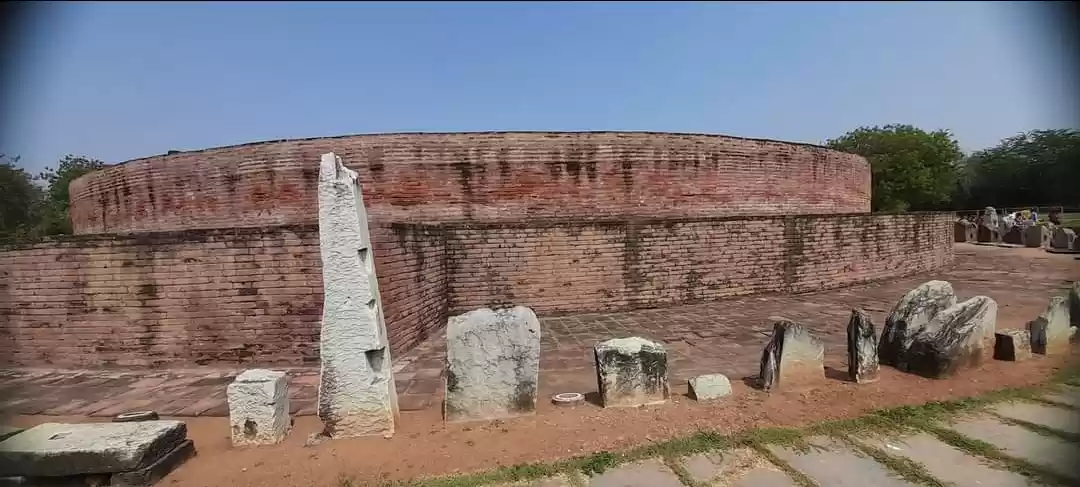
Travel Blogs for Amaravathi Stupa
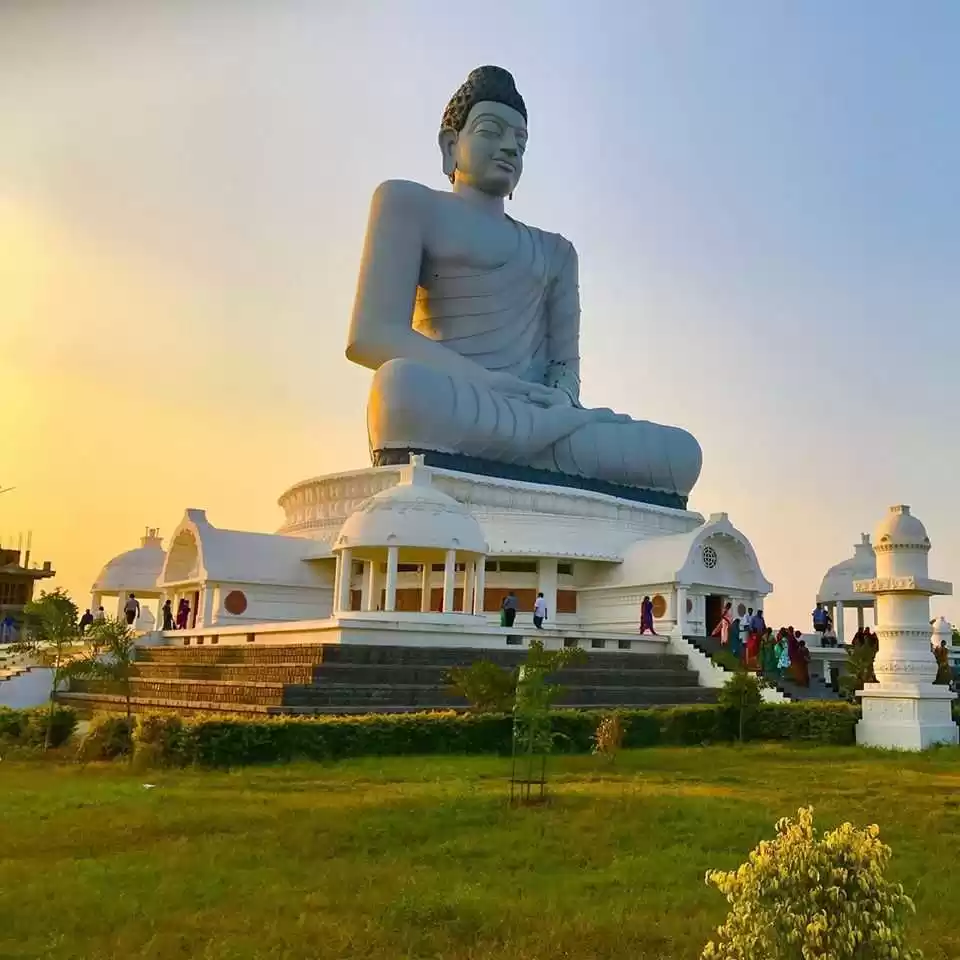
Places To Visit In Guntur
Top hotel collections.

3 Star Hotels
- Filter (13)
- Monument (2)
- Historical Site (1)
- Waterfall (1)
1. Nagarjuna Sagar Dam and Ethipothala Falls

113 km from city center 1 out of 13 Places To Visit in Guntur
An exquisite sight of a massive irrigation project constructed over River Krishna, Nagarjuna Sagar Dam is situated around 100 miles from the city of Guntur.
2. Kondaveedu

20 km from city center 2 out of 13 Places To Visit in Guntur
Kondaveedu is a place lying about 17 miles from Guntur city adorned with one of the most popular tourist attractions of the region. It houses an ancient fort belonging to 14th century AD built by Reddy kings which comprises of 21 magnificent structures.
3. Uppalapadu Nature Conservation

8 km from city center 3 out of 13 Places To Visit in Guntur
A place to admire large number of endangered species of Birds, Uppalapadu Nature Conservation is situated in the southern side of the city.
4. Kotappakonda Trikutaparvattam

47 km from city center 4 out of 13 Places To Visit in Guntur
Originally known as Kondakavuru, this place is famously known as Kotappakonda or Trikutaparvattam meaning three peaked hill which actually lies nearby.
Top Hotels In Guntur
₽ 851 onwards
5. Mangalagiri

20 km from city center 5 out of 13 Places To Visit in Guntur
Mangalagiri, lying 13 miles northeast of Guntur city is mainly renowned for its famous temple of Lord Lakshmi Narasimha Swamy. At the temple, the devotees worship the lord by offering jiggery water.
6. Downtown, Guntur

2 km from city center 6 out of 13 Places To Visit in Guntur
The city of Guntur is comprised of its own downtown area, midtown and residential areas. This place is packed with myriad of tourist attractions which include Center of Brodipet, Arundelpet, Jinnah Tower Center, Naaz Center, Brindavan Gardens, Old Guntur and Inner and Outer Ringroads.
7. Amaravathi

31 km from city center 7 out of 13 Places To Visit in Guntur
A place situated about 16 miles from Guntur is packed with a famous holy shrine and site of great historic importance. The place itself is named after a renowned temple lying in the area namely Amareswara Swamy which inhabits Swayambhu Linga.
8. Viswa Nagar

2 km from city center 8 out of 13 Places To Visit in Guntur
Situated in the south-west part of the city, Viswa Nagar can be easily approached via a National Highway 5 i.e. GNT-Chennai Expressway. The place is renowned for Universal Integration Pillar and Viswayogi Viswamji.
9. Krishna Barrage

29 km from city center 9 out of 13 Places To Visit in Guntur
Krishna Barrage or Prakasam Barrage lies 18 miles from the city of Guntur. It is constructed over Krishna River all the way connecting Guntur with Krishna District.

41 km from city center 10 out of 13 Places To Visit in Guntur
Mid-January is considered as an important time in the Tamil calendar. The harvest festival, Pongal, typically falls on the 14th or the 15th of January and is celebrated in an exemplary mode of 'Tamil Culture'. Guntur has a lavish celebration of Pongal that anybody interested in observing local cultures should not miss.
11. Suryalanka Beach

52 km from city center 11 out of 13 Places To Visit in Guntur
Suryalanka Beach is a lesser-known gem situated near Bapatla near Guntur. The beach is famous for the sweeping views of the sun, sea and sand. It is also ideal for swimming.
12. Bhattiprolu

43 km from city center 12 out of 13 Places To Visit in Guntur
Located in the Guntur district in the state of Andhra Pradesh, Bhattiprolu is a small village which is mainly known for its Buddhist stupa that is a centrally protected monument of national importance.
13. Amaravati Stupa

31 km from city center 13 out of 13 Places To Visit in Guntur
Amaravati Stupa is a heritage monument, and ancient Buddhist stupa located in the Amaravathi. The memorial is currently under the protection of the Archaeological Survey of India. Popularly known as the Mahachaitya, Deepaladinne or the Great Stupa of Amaravati, this is among the largest stupas in India and one of the most visited sites in Amaravati.
Places To Visit In Nearby Places

FAQs on Guntur
What are the top sightseeing places in guntur, how can i commute within guntur, can you suggest an itinerary for guntur, browse hotel collections, by hotel type.
Villas In Guntur
By Star Category
3 Star Hotels In Guntur
Similar Places

Filter ( 0 selected)
Get the best offers on travel packages.
Compare package quotes from top travel agents
Compare upto 3 quotes for free
- India (+91)
*Final prices will be shared by our partner agents based on your requirements.
Log in to your account
Welcome to holidify.
Forget Password?
Share this page
- India Tour Packages Shimla Manali Kullu Goa Kashmir Spiti valley Srinagar Nainital Dalhousie Mussoorie Ooty Munnar Kerala Andaman Sikkim Himachal Pradesh International Tour Packages Thailand Singapore Sri Lanka Mauritius Maldives Dubai Bhutan Seychelles Bali Switzerland New Zealand Hong Kong --> Azerbaijan Istanbul Greece Italy United Kingdom
- Auto Itinerary
- Register as a Travel Agent
- Places To Visit
- Tour Packages
- How to Reach
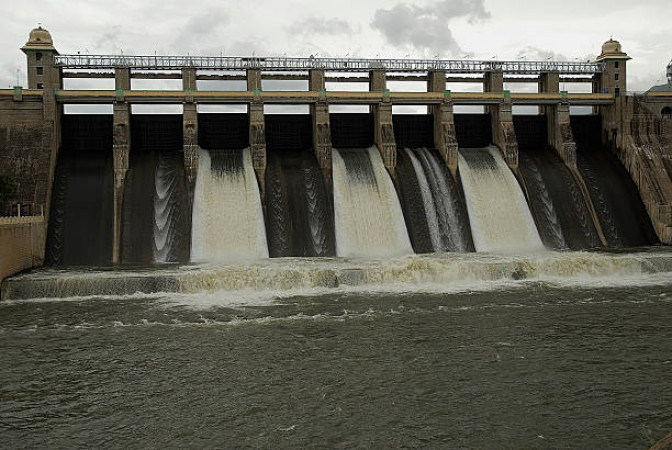
About Amaravathi
Top 3 places to visit in amaravathi.
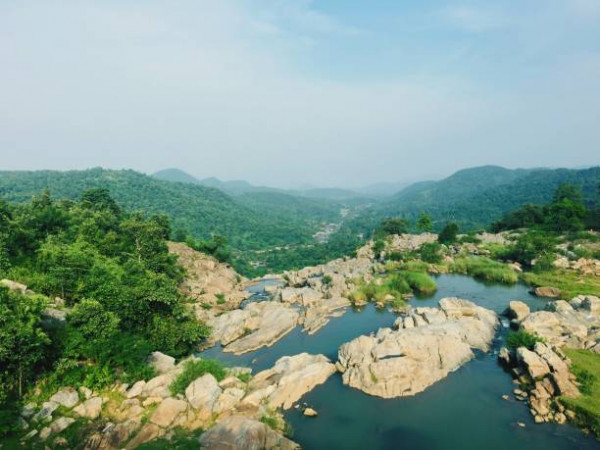
FAQ's on Amaravathi
What is famous about amaravathi, what is not so good about amaravathi, who should visit amaravathi, what is the best time to visit amaravathi, what is the local food in amaravathi, what is the best way to reach amaravathi, how much does a package cost for amaravathi, what are the places near amaravathi, help & support, call us now, +91-8069145442.
Modal title

COMMENTS
2. Amaravathi Archaeological Museum. 47. History Museums. By Suryakatakam. Amaravati Archaeological Museum is Located in Amaravati village of Guntur District, which is @35 km away from District... 3. Dhyana Buddha Statue.
Dhyana Buddha Statue. #4 of 6 Places to Visit in Amaravati. At a distance of 2 km from Amaravati Bus Station, the Dhyana Buddha is a statue of Lord Buddha situated in Amaravati, Andhra Pradesh. It is one of the tallest Buddha statues in India and among the most important places to visit in Amaravati. Standing tall at a height of 125 feet, the ...
Get the best Information about Amaravathi Tourism. Get travel guides and plan your trip to Amaravathi with tour packages, places to visit, sightseeing, hotels, and reviews by other travellers. ... The top places near to Amaravathi are Guntur which is 30 km from Amaravathi, Vijayawada which is located 31 km from Amaravathi, Papi kondalu which is ...
Places To Visit In Amaravathi - Discover The Serene Beauty Of Amaravathi With Our Complete Amaravathi Tourism Guide Written By Local Destination Expert ... Amaravathi Archaeological Museum, located in Amaravathi, Guntur district, Andhra Pradesh, India, is .. Click here for more information about Amaravathi Archaeological Museum. Historical ...
Amaravathi Tourism: Tripadvisor has 107 reviews of Amaravathi Hotels, Attractions, and Restaurants making it your best Amaravathi resource. ... Sign in. Amaravathi Hotels Things to Do Restaurants Flights Vacation Rentals Cruises Rental Cars Forums. Asia. India. Andhra Pradesh. Guntur District. Amaravathi. Amaravathi. ... Places to see, ways to ...
Amaravathi is a town located on the banks of the Krishna River in the Guntur district of Andhra Pradesh, India. It has been recognized as a site of great historical, cultural, and architectural significance in Southern India. Amaravathi is earmarked to be developed as the new capital city of Andhra Pradesh after the state's bifurcation.
Guntur District. Amaravathi. Amaravathi. Amaravathi Tourism Amaravathi Hotels Amaravathi Guest House Amaravathi Flights Amaravathi Restaurants Amaravathi Attractions Amaravathi Travel Forum Amaravathi Photos Amaravathi Map. Hotels. All Amaravathi Hotels Amaravathi Hotel Deals Near Landmarks.
Ideal visit duration: 1 to 2 hours. Closed in: Open all year. Amareswara Temple, situated in Amaravathi town in the Guntur district of Andhra Pradesh, is dedicated to Lord Shiva, known here as Amareswara or Amaralingeswara. This ancient temple is associated with the Amararama, one of the five Pancharama Kshetras, which are significant shrines ...
Discover the majestic charm of 18 Places to Visit in Guntur, Andhra Pradesh. Know the details like timings, entry fees, best time, etc with our travel guide! Christmas & New Year; Corporate Tours; ... Amaravathi is one of the top tourist attractions in Guntur. Amaravathi known as the capital of Andhra Pradesh, is a planned city located along ...
Amaravathi travel guide, tourism, weather information, how to reach, route map, photos & reviews of Amaravathi by travellers on Tripoto. Inspirations . ... Guntur District, Amaravathi 522403. Amaravathi Archaeological Museum. Guntur District, Amaravathi 522403. Amaravathi Stupa. See all.
📍 Guntur District, Amaravathi 522403 View map › 🗓 Best Time To Visit: October to March. ⏰ Open Hours: 8 AM to 6 PM. 🏞 Things To Do: Visit the stupa, museum exploration, photography, sightseeing. 💰 Entry Fees: Free entry. 👥 Traveller Types: Historians, Culture enthusiasts, Photo Fanatics, Family.
Top Things to Do in Amaravathi, India: See Tripadvisor's 107 traveller reviews and photos of Amaravathi tourist attractions. Find what to do today, this weekend, or in August. ... Amaravati Archaeological Museum is Located in Amaravati village of Guntur District, which is @35 km away from District... 3. Dhyana Buddha Statue. 1. Points of ...
Amaravati Mahachaitya is one of the most prominent sites of Buddhist pilgrimage in south India ; so important is this monument that the Dalai Lama paid a visit a few years ago and tied prayer flags on the railing surrounding its circulatory path. The structure is reminiscent of the gompas in the Himalayas. Locally, the mahachaitya is known as ...
Amaravathi Archaeological Museum. Amaravati Archaeological Museum is Located in Amaravati village of Guntur District, which is @35 km away from District headquarters. This Museum discloses the sculptures in the form of galaxy of and the images showcase content that were once a part of the Giant Stupa. There are three Galleries in this Museum ...
Amaravathi is a beautiful little town that sits peacefully on the banks of the Krishna river. It falls in the Guntur district of Andhra Pradesh, which is a South Indian state. It should not come off as a surprise that Amaravathi is a world-known tourist attraction spot. Thank the magnificent Amareswara Temple for that.
This place is packed with myriad of tourist attractions which include Center of Brodipet, Arundelpet, Jinnah Tower Center, Naaz Center, Brindavan Gardens, Old Guntur and Inner and Outer Ringroads. Read More. 7. Amaravathi. 3.1 /5. 31 km. from city center 7 out of 13. Places To Visit in Guntur.
Things to Do in Amaravathi, India: See Tripadvisor's 107 traveler reviews and photos of Amaravathi tourist attractions. Find what to do today, this weekend, or in August. ... Amaravati Archaeological Museum is Located in Amaravati village of Guntur District, which is @35 km away from District... 3. Dhyana Buddha Statue. 1. Points of Interest ...
Amaravathi Travel Guide : Know Tourist Places to Visit in Amaravathi, Best Time to Visit, Attractions, Nearby Places to visit, Sightseeing, Weekend Getaways, Things to Do and How to Reach. ... Amaravathi, a small town that was established on the banks of the river Krishna, lies in the Guntur district of the south Indian state of Andhra Pradesh ...
Amaravathi is a village in Guntur district of the Indian state of Andhra Pradesh. It is located in Amaravati mandal of Guntur revenue division. Amaravathi is one of the ancient villages in Guntur district. The village was ruled by the Reddy dynasty. The village has a population of around 3000. The village is located on the banks of the Krishna ...
5. Amareswara Temple. 36. Points of Interest & Landmarks. By Suryakatakam. Amareshwara temple is located in Amaravati town of Guntur District, Andhra Pradesh. This temple is located on southern... 6. Sri Sri Radha Krishna Chandra Temple.
Guntur; Places to visit in Guntur; Amaravathi; Amaravathi Guntur. Crocodile Breeding Site. 1 / 6. Previous. Next. Overview. ... When you are in a new city, you can possibly see places and people that you wouldn't normally see when simply walking to the places that checks your list. Some buses or rails take you to parts of the city you wouldn ...
Top Things to Do in Amaravathi, Guntur District: See Tripadvisor's 107 traveller reviews and photos of 4 things to do when in Amaravathi. Skip to main content. Discover. Trips. Review. SGD. ... Must visit place in amaravati local as site seeing , the collection of art and work is really appreciable , magnificent and awesome . Read more.
Things to Do in Amaravathi, India: See Tripadvisor's 107 traveller reviews and photos of Amaravathi tourist attractions. Find what to do today, this weekend, or in August. ... Amaravati Archaeological Museum is Located in Amaravati village of Guntur District, which is @35 km away from District... 3. Dhyana Buddha Statue. 1. Points of Interest ...